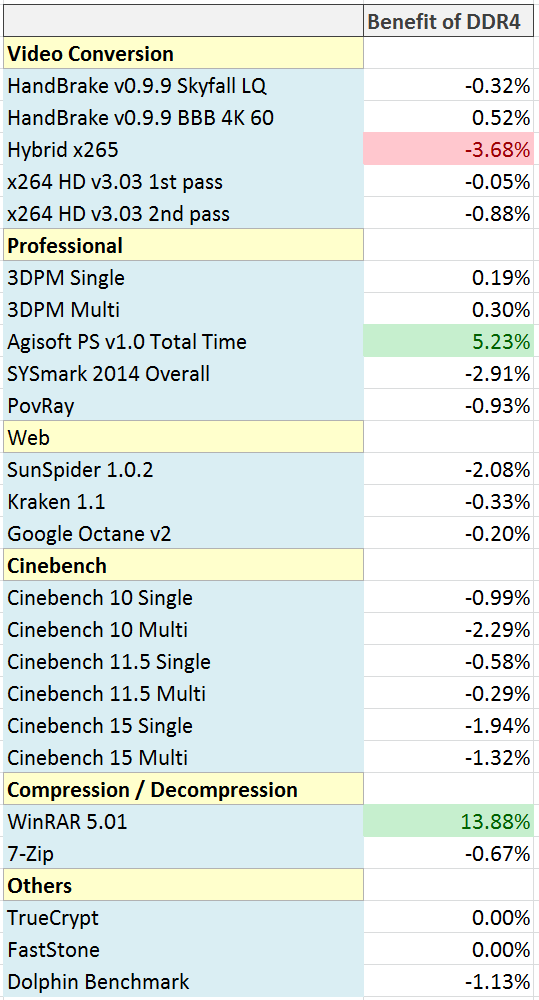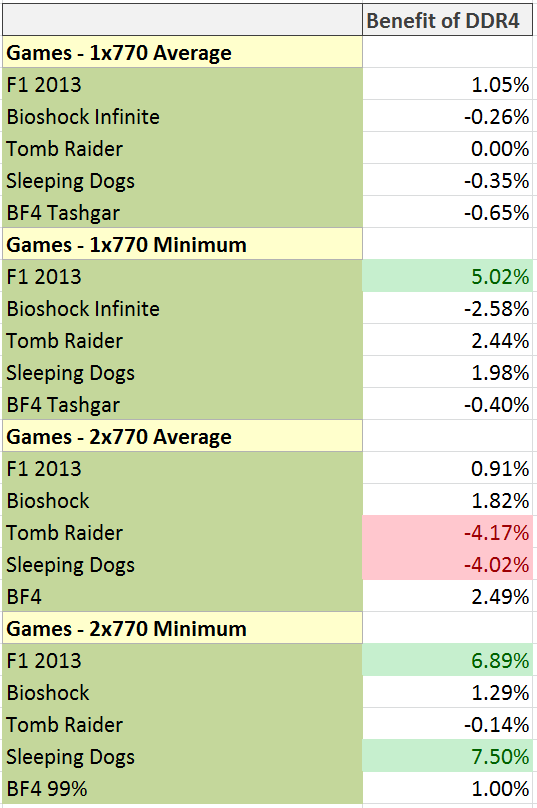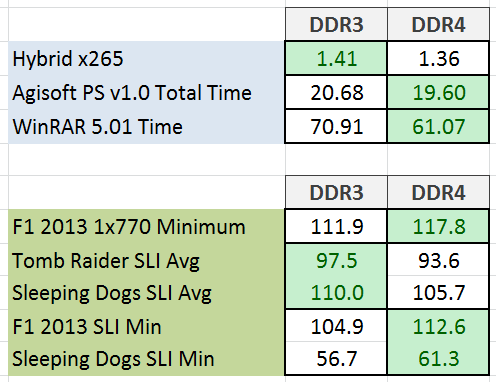DDR4 Haswell-E Scaling Review: 2133 to 3200 with G.Skill, Corsair, ADATA and Crucial
by Ian Cutress on February 5, 2015 10:10 AM ESTComparing DDR3 to DDR4
Moving from a standard DDR3-2133 C11 kit to DDR4-2133 C15, just by looking at the numbers, feels like a downgrade despite what the rest of the system is. Ideally we want the first number, the frequency, to be high and the second number, the latency, to be low. After spending several years dealing with DDR3, moving to DDR4 feels a bit of a backwards step when you look at solely the numbers on paper.
As part of this review we have covered many different areas where DDR4 is the upgrade of DDR3, not only in terms of voltage but some of the underlying concepts as well. This puts DDR4 in a position for upgradability in the future, especially when it comes to density and future technologies (see the next page for more information). But an ultimate question still remains: at the same frequency and latency, do they perform the same?
The only way to perform an identical comparison would be to have a platform that could probe both DDR3 and DDR4 while keeping the same CPU. If one comes along, we will test that, but in the mean time we can do some broad comparisons with near-identical systems.
For this test we took two Haswell based systems and compared them against each other. The first contains the Haswell-E i7-5960X processor, cut it down to run at four cores with no HyperThreading, fixed the CPU speed at 4 GHz and placed the memory into DDR4-2133 14-14-14 350 2T timings. We did the same with the second system, a Haswell based i7-4770K moved it to 4 GHz and making sure it was in 4C/4T mode. The OS was placed into a unique high performance profile and we ran our test suite. The only difference that remained between the two setups was the L2 and L3 cache, which we cannot change unfortunately.
In our non-gaming tests, there is one situation where DDR3 is more than 3% better and two where DDR4 is +3%. It is worth noting that most of the numbers, especially with things like the Web and Cinebench are actually slightly negative.
In the gaming tests, similarly there are more +3% on the side of DDR4. If we do a direct comparison regardless of the percentage, DDR4 wins 11 times compared to DDR3 getting 8, and almost of DDR3’s wins are minor except for two-way SLI. It would seem that for two-way SLI DDR4 at least brings up some of the minimum frame rates.
Pulling out the >3% difference numbers, just to see what the numbers exactly are:
On the face of it, the Hybrid result does not seem that different, whereas a full minute on Photoscan or 10 seconds in our WinRAR test feels like a difference. In the gaming tests moving nearer to 120 FPS or 60 FPS, especially in both of the minimum frame rate tests, is an important jump which happens with DDR4.
Overall, comparing DDR4 to DDR3, there is little difference to separate the two. In a couple of small instances one is better than the other, but on those edge cases it might be prudent to say that we cannot make a final decision until we can synchronize the rest of the system, such as the size of CPU caches. When we can perform such tests, we will run some more numbers.













120 Comments
View All Comments
Flunk - Thursday, February 5, 2015 - link
"There is one other group of individuals where super-high frequency memory on Haswell-E makes sense – the sub-zero overclockers."Yeah, I'm sure the 200 people on the planet who care about that are a real big market...
Nice article overall though. I don't know why, but I was expecting more from DDR4. It looks like there is little reason to upgrade right now. Although I expect we'll all end up being forced into it by Intel.
Antronman - Thursday, February 5, 2015 - link
There's a lot of consumers who want high clocked memory just because they want it.And there's more than 200 extreme overclockers on the planet.
galta - Thursday, February 5, 2015 - link
The reason to upgrade today is not DDR4 per se, but 5xxx CPUs, and you might want these CPUs because of the extra cores, extra pci lanes, both, or just because you want it and can pay for it.These discussions over RAM get me tired. Rocks on the streets know that:
a) fast memory makes close to no difference in real world, especially today with overclocking being so much more friendly than it was in the past
b) whenever a new standard is introduced, it performs poorly when compared to previous standard. It was like this with DDR3 back in 2008 and it's the same today, but today you probably have less than 200 people saying they miss DDR2.
Let's discuss more interesting and reasonable subjects.
Murloc - Thursday, February 5, 2015 - link
200? You're severely underestimating the number of people who do that.Also why do car companies make cars that are going to be driven by just a few sheiks?
With rams it's probably even easier given that you just have to bin chips and there are people who buy them just because they want the best. That's why they put increasingly cooler heatsinks and packages on the more pricey sticks. Not because they really need additional cooling in non-extreme use cases.
FlushedBubblyJock - Sunday, February 15, 2015 - link
Because the elite cater to the elite, and the clique' is small and expensive, and leeches off the masses for the advantage and opulent and greedy lifestyle and media hype and self aggrandizement.They can fly each other around the world for huge parties and giveaway gatherings called global contests and spend enormous sums and feel very important.
imaheadcase - Thursday, February 5, 2015 - link
Wait a tick, DDR2 is 800+mhz. That is what its default to on both my systems.imaheadcase - Thursday, February 5, 2015 - link
You put 200-533 MHz. My is actually at 936mhz for the overclock to.ZeDestructor - Thursday, February 5, 2015 - link
DDR = Double Data Rate, i.e: two operations are done per clock cycle. Thus the frequency is 400, but the effective frequency is 800. Same applies for DDR1-DDR4.GDDR5 is crazier: 4 operations per clock cycle, so 1750MHz works out to 7000MHz effective.
Murloc - Thursday, February 5, 2015 - link
so basically what we knew all along: many enthusiasts are just wasting their money. The same goes for size although few people who build PCs are that stupid when it comes to this, it's mostly gamers who buy pre-built PCs who fall into this trap (it's not like they have much of a choice anyway, everybody is selling computers with lots of RAM and a pricey CPU bottlenecked by a weak GPU because it makes them money).fredv78 - Thursday, February 5, 2015 - link
seems to me most benchmarks are within the error margin (which is usually up to 3% and ideally should be quoted)